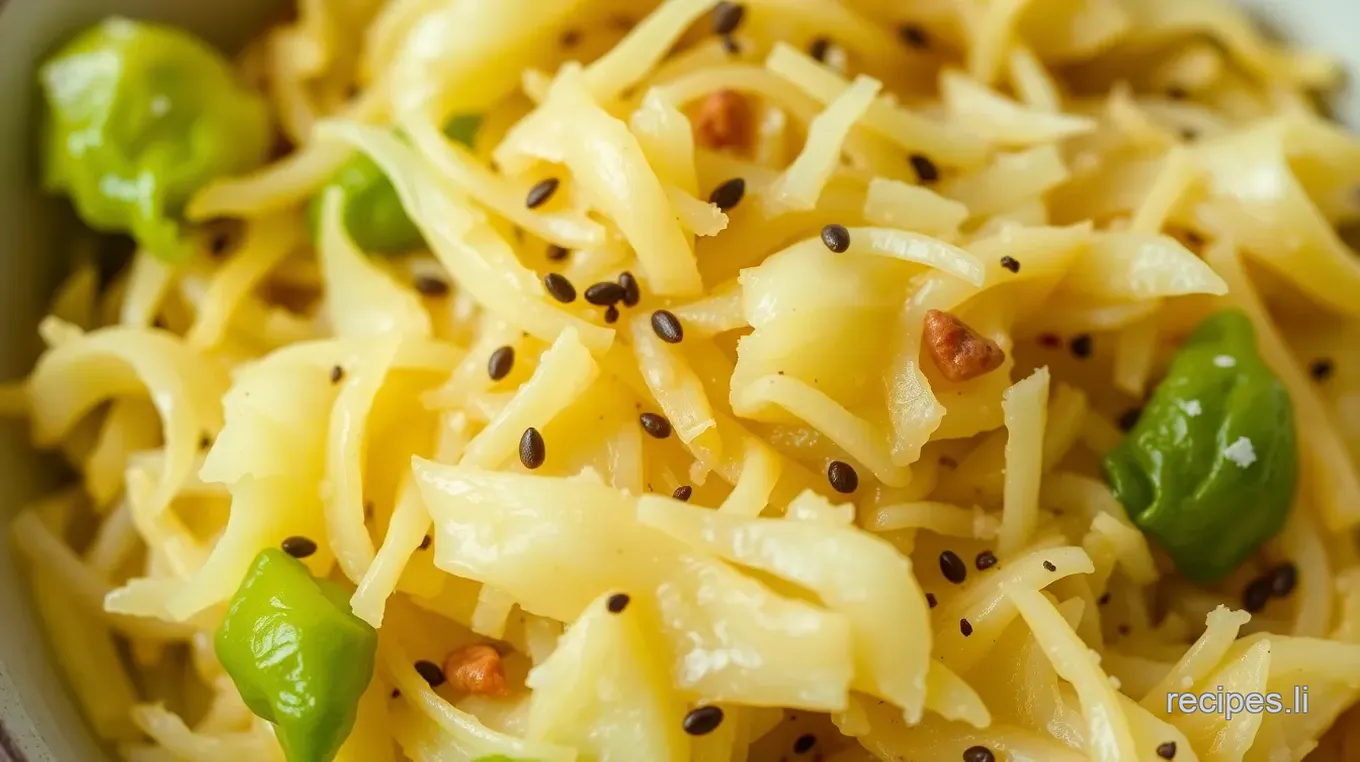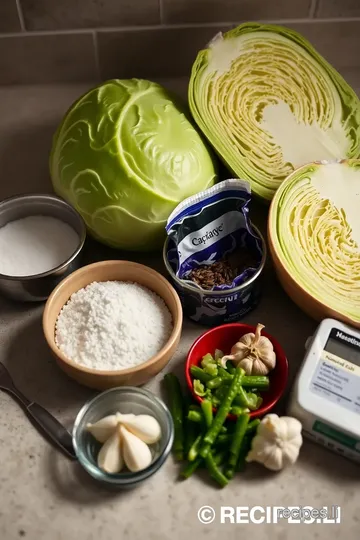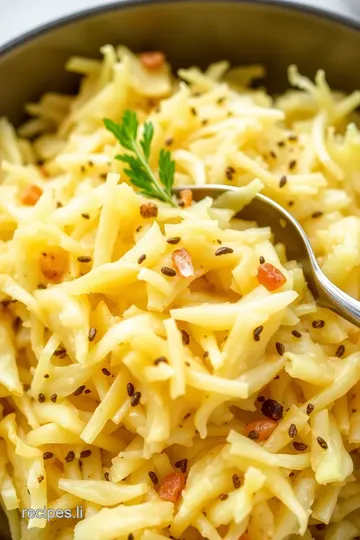Tangy Homemade Sauerkraut with Cabbage
Have you ever wanted to try making sauerkraut at home? Join me in crafting tangy sauerkraut with cabbage! It’s a simple process and full of probiotic goodness.

- Unleashing the Funk: Crafting Tangy Sauerkraut with Cabbage
- Essential Ingredients Guide
- look into into the World of Professional Cooking: Crafting Tangy Sauerkraut with Cabbage
- Pro Tips & Secrets for Crafting Tangy Sauerkraut with Cabbage
- Storage & Make-Ahead
- Creative Variations
- Complete Nutrition Guide
- Encouraging Conclusion
- Frequently Asked Questions
- Recipe Card
Unleashing the Funk: Crafting Tangy Sauerkraut with Cabbage
Oh man, let me tell you about the first time i tried to make sauerkraut . i was just a curious newbie in the kitchen, high on excitement and a little too ambitious.
I stumbled across this homemade sauerkraut recipe and thought, “how hard can it be?” well, let me tell you, my kitchen smelled like a science experiment gone wrong for days! but guess what? after a week of waiting with bated breath, i opened that jar and tasted magic.
Seriously, it was life-changing! today, i'm sharing my tips and tricks to get you crafting tangy sauerkraut that’ll impress everyone at your next dinner party!
A Little History Before We Dig In
So, where did this deliciousness come from? sauerkraut has its roots in germany, tracing back centuries as a staple in various traditional german recipes.
With the rise of fermented foods , sauerkraut has enjoyed a renaissance, becoming a darling in modern kitchens. it’s super popular now, thanks to its deliciously tangy flavor and a ton of health benefits .
Plus, it’s an easy way to get into easy fermentation techniques !
Now, i know you’re busy, so here’s the scoop: this delicious blend takes about 15 minutes to prep and then your only job is to be patient for about 1 to 4 weeks while it ferments.
Yup, you can kick back, relax, and let the mixture do its thing. all you need is a couple of heads of cabbage and a sprinkle of sea salt, and bam! you're practically a mad scientist of the culinary world!
Why You’ll Love It
Let’s talk benefits. first off, sauerkraut isn't just tasty; it’s packed full of probiotics , which are essential for gut health.
Seriously, these little guys are like the superheroes for your digestives! according to the cdc, only about 1 in 10 adults get the recommended daily fruit and vegetable intake.
But by adding fermented cabbage to your meals, you’re boosting that number and your nutrition with minimal effort.
Oh, and guess what? homemade sauerkraut not only makes a fantastic side dish but is also a game-changer for everything from sandwiches to salads.
You can jazz it up with caraway seeds for a classic twist or even grated carrots for a touch of sweetness.
If you’re thinking about hosting a dinner party, this pickle perfect delight is great for impressing guests. trust me, they’ll be asking, “how did you make this?”
A Few Practical Considerations
Now, i gotta keep it real with you about costs. making your own sauerkraut is not just fun; it’s incredibly budget-friendly.
A medium cabbage running you less than a couple of bucks will yield about 4 cups of that crunchy goodness.
Great flavor at a fraction of the cost of buying store-bought!
And let’s not even get started on storage. your sauerkraut will keep in the fridge for months, and the best part is, it only gets tastier as it continues to ferment.
So whether you’re hoarding your homemade goodies or just keeping some on hand for those “i don’t feel like cooking” nights, you’re set!
Transitioning to Crafting
Ready to dive into how to make sauerkraut ? let’s grab those ingredients and journey into the exciting world of cabbage fermentation process ! get your fermentation jars and let’s get those probiotics working their charm.
If you’re like me and love a little tang and crunch in every bite, stick around for the ingredient list.
Trust me, you’re going to want to experience the zesty joy of homemade sauerkraut once you get the hang of it!
The next step is all about assembling what you need to unleash those delicious flavors. Let’s go!

Essential Ingredients Guide
Alright, let’s chat about the essentials you need for crafting tangy sauerkraut with cabbage and bringing this deliciousness into your kitchen! making homemade sauerkraut is not just a fun kitchen project; it's also about harnessing the goodness of fermented cabbage packed with health benefits.
This guide will help you nail down the essential ingredients , so you can dive right into fermentation with confidence.
Premium Core Components
First off, the premium ingredients . you might be wondering about measurements. for this sauerkraut recipe, you’ll need 1 medium green cabbage (about 2 pounds / 900 grams ) and 1 tablespoon of sea salt (roughly 15 grams ).
Simple, right?
Next, let's talk about quality. look for a cabbage that’s firm and heavy for its size—this means it’s fresh. you don’t want a wilty cabbage; that’ll just ruin your cabbage fermentation process .
Storage guidelines are pretty straightforward: keep your cabbage in the fridge if you’re not using it right away. avoid storing it in a plastic bag; that just gives it the chance to sweat and go bad quicker.
The shelf life of a fresh cabbage can be up to two weeks in the fridge.
Also, when you pick your cabbage, try to choose during peak season, usually late summer through fall, for the best flavor.
Signature Seasoning Blend
Now for the fun stuff: seasonings! you can keep it classic with just salt or jazz it up with caraway seeds for that traditional german recipes vibe.
Could also add a bit of grated carrot for sweetness—it’s all about your preference! those flavor enhancers can make a world of difference.
Don't forget about exploring regional variations. For instance, some folks love adding spicy pepper flakes for a kick, while others enjoy adding garlic. Honestly, there are endless possibilities!
Smart Substitutions
Let’s say you’re in a pinch and don’t have sea salt on hand. no worries! you can substitute kosher salt, just keep in mind that it might affect the fermentation.
Need a lower-sodium option? just reduce the salt, but know that may impact your sauerkraut’s flavor bat and fermenting power.
If you’re feeling adventurous and want to experiment with different cabbage varieties , red cabbage will give you a gorgeous color and unique flavor. Super fun for DIY sauerkraut !
Kitchen Equipment Essentials
Now, moving on to equipment essentials . you’ll need some must-have tools: a mixing bowl, a sharp knife (or cabbage shredder for convenience), a large glass jar or earthenware crock (at least 1 quart / 1 liter capacity), and a weight to keep everything submerged.
I once tried using a smaller jar filled with water as a weight, and it worked like a charm! Just be sure your tools are clean— sanitizing them helps ensure healthy fermentation.
Storage? After making your sauerkraut, keep it in the fridge. It’s happy in there for several months, just waiting to jazz up your meals while giving a boost to your gut health and adding those probiotic-rich foods to your diet!
Closing Thoughts
And there you have it! with these essential ingredients and tips in your back pocket, you’re ready to embark on your sauerkraut journey.
From the cabbage fermentation process to ultimately tasting that delicious tanginess, this experience is not only rewarding but can also bring loads of flavor to your meals.
Now, before we dive into the step-by-step of how to make sauerkraut , gather your ingredients, tools, and let’s get this fermentation party started! Trust me, you’ll want to stick around for the next section where I’ll share all the good details for crafting tangy sauerkraut with cabbage !

look into into the World of Professional Cooking: Crafting Tangy Sauerkraut with Cabbage
So, you're ready to embark on a culinary adventure, eh? making homemade sauerkraut can be your gateway into the realm of professional cooking! this fermented cabbage delight is not just a delicious condiment; it’s a powerhouse of probiotic-rich foods that does wonders for your gut health .
Let me walk you through some essential preparation steps and then we'll dive right into the sauerkraut magic.
Essential Preparation Steps
Mise en place : this fancy french term just means “everything in its place.” before you start making your sauerkraut, gather your ingredients and tools.
You’ll need a medium green cabbage, sea salt, and maybe some caraway seeds if you’re feeling a bit adventurous! trust me, having everything out saves time and stress, making your cooking experience smoother.
Time management tips : ever lost a measure of salt or realized you forgot to wash the jar? well, i’ve been there.
Make a quick checklist to avoid missing essential steps. cabbage will ferment at its own pace, but prepping your tools beforehand makes life easier.
Organization strategies : keep your workspace tidy—they say cleanliness is next to godliness! as you chop the cabbage, make sure to clean as you go.
You'll thank yourself later. that’s how pros do it!
Safety Considerations : Once you start fermenting, remember this: cleanliness is key! Ensure your jars and tools are sterilized. Nobody needs funky bacteria ruining your beautiful sauerkraut.
Step-by-Step Process to that Tangy Goodness
Alright, let’s break it down to the nitty-gritty. Follow these steps for the best results.
-
Prepare Your Cabbage : Remove the outer leaves (save them!). Quarter the cabbage and slice it finely.
-
Combine cabbage and salt : in a bowl, sprinkle 1 tablespoon of sea salt over your shredded cabbage. now, get your hands in there, and massage it for 5- 10 minutes .
You want the cabbage to release its juices; it’s like giving your veggies a spa day!
-
Optional Add-ins : Want a twist? Add 1 teaspoon of caraway seeds or a grated carrot for a hint of sweetness.
-
Pack the Jar : Transfer that beautiful mixture into a clean jar, pressing it down to eliminate any air pockets.
-
Weight and cover : throw that reserved cabbage leaf on top and add your weights to keep everything submerged. cover with a clean cloth to let the jar breathe while keeping dust away.
-
Fermenting time : store your jar in a cool, dark place. check it daily! after about one week , take a taste.
Like it tangy? let it go longer, up to 4 weeks .
-
Store in the Refrigerator : Once you're happy with the flavor, toss it in the fridge, where it’ll stay good for months.
Expert Techniques for Sauerkraut Perfection
Now that you’ve got your sauerkraut laid out, let’s chat about feeling like a pro while doing it!
-
Temperature Control : Aim for a consistent room temperature between 65° F and 75° F ( 18° C and 24° C) for ideal fermentation.
-
Timing Precision : Remember, less is more when it comes to time. Fermentation is like the slow-cooker of the veggie world—good things take time!
-
Visual Cues for Doneness : Watch for bubbles and that beautiful, sour aroma. If you see mold on the surface? Skim it off; it’s still good underneath.
-
Troubleshooting Tips : If it doesn’t taste right or smells funky, don’t panic. Adjust the salt in future batches or consider your space temperature.
Success Strategies for Fermenting at Home
Now for a few golden tidbits that'll help you shine in your sauerkraut journey:
-
Common Mistakes to Avoid : Overpacking the jar can hinder proper fermentation. Don’t rush; layering is key!
-
Quality Assurance Tips : Taste as you go. If you think it’s losing its zing, let it ferment longer.
-
Perfect Results Guide : Remember, patience is critical. A week or two in may seem long, but flavors deepen the longer it sits.
-
Make-ahead Options : You can make big batches and store them in the fridge. They’ll be ready for all those holiday feasts or picnics.
Honestly, crafting tangy sauerkraut with cabbage is a great way to level up your cooking skills while reaping the health benefits of sauerkraut .
So, what’s next for you? fermenting a new flavor or trying out different cabbage variations?
Stay tuned for more tips and recipes in the Additional Information section!

Pro Tips & Secrets for Crafting Tangy Sauerkraut with Cabbage
So, you’re diving into crafting tangy sauerkraut with cabbage ? awesome choice! let me share some of my favorite pro tips that i've picked up over the years.
First off, massage that cabbage like you mean it! give it a solid 5 to 10 minutes of your best hand-squeezing skills.
This helps release all those lovely juices. you’ll see why later!
Time-Saving Techniques
Got a busy schedule? i get it. here’s a little trick: you can prep multiple jars of sauerkraut at once.
Just double or triple the recipe. it'll save you time in the long run, plus you’ll have a tangy stash ready to go!
Flavor Enhancement Tips
Want to jazz things up a notch? consider tossing in some caraway seeds or grated carrots. they not only add a pop of flavor but also create a little color variation.
Honestly, when i add caraway, it reminds me of my grandma's kitchen; it brings me back to family dinners with zingy sausage and warm bread.
Perfect Presentation
Alright, let’s talk about making your sauerkraut look as good as it tastes. plating techniques can be super simple but make a huge difference.
Try laying a colorful scoop of sauerkraut next to some grilled sausages or atop a vibrant salad. garnish with fresh herbs like parsley for that chef-level appeal.
Yep! your friends will think you’re a culinary magician.
Garnish Ideas
You can also sprinkle in some fresh dill or even a few slices of radish for an unexpected crunch. trust me; your plate will not just look like food; it’ll look like an instagram-ready masterpiece.
Storage & Make-Ahead
Speaking of making things easy, let’s chat about storage tips . once you’ve lovingly crafted your sauerkraut, you'll want to know how to keep it fresh.
Store it in a glass jar with a tight lid in the fridge. it can last for several months, which is perfect because you’ll probably want to whip some out for cookouts or sandwiches.
Preservation Methods
If you want to take it further, consider canning your sauerkraut. But, heads up: that's a little more advanced! If that’s not your thing, just keep it chilled, and you’re golden.
Freshness Duration
Typically, homemade sauerkraut stays fresh for about 4 to 6 months in the refrigerator. just keep an eye on it; if it starts losing its crunch or smells funky, it’s time to let it go.
Creative Variations
Now that you’re a sauerkraut pro, why not get a little creative?
Flavor Adaptations
Feel adventurous? Explore different flavors! Try adding garlic , chili flakes, or even a splash of apple cider for zest. You can turn ordinary sauerkraut into a tangy masterpiece!
Dietary Modifications
If you're watching your salt intake, go easy on the sea salt. Just remember, it might impact the fermentation process a little.
Seasonal Twists
Keep it fun by using seasonal veggies. In fall, throw in some grated apples for a sweet and tangy mix. You might surprise yourself with how delicious it turns out!
Regional Variations
Embrace the world of regional recipes ! In some cultures, you might find additions like beets or other root vegetables. Experimenting could lead you to your next favorite dish.
Complete Nutrition Guide
Alright, folks! let’s break down the nutritional value of sauerkraut . it’s like a little treasure trove of goodness! each serving is low in calories and loaded with fiber.
Plus, it helps with improving digestion thanks to all those healthy probiotics.
Health Benefits of Sauerkraut
You’ve got to love that it also boosts gut health ! Fermented foods like homemade sauerkraut are awesome for your immune system, too.
Dietary Considerations
Just remember, some folks might need to keep their sodium in check. So it’s always a good idea to know your audience if you’re sharing this delightful dish.
Portion Guidance
A half cup is a solid serving size, perfect as a side or a topping. So load up your plate with goodness!
Encouraging Conclusion
In the world of cooking, experimentation is everything! so don’t be shy—get in there, tweak the recipe, and make it your own.
Sauerkraut variations and substitutions are all part of the fun! trust me, making your own homemade sauerkraut will not only boost your meals but also give you a fantastic sense of accomplishment.
Happy fermenting, friends! you’ve got this!
Frequently Asked Questions
What is the secret to successfully crafting tangy sauerkraut with cabbage?
The key to tangy sauerkraut lies in the balance of salt and fermentation time. Use the right amount of sea salt (about 1 tablespoon per medium cabbage) and allow the mixture to ferment at room temperature for at least one week, adjusting the time based on your desired tanginess. Tasting periodically will help you find the perfect flavor.
How can I store my homemade sauerkraut?
Once your sauerkraut has fermented to your liking, transfer it into a clean jar and store it in the refrigerator. It will remain fresh for several months when kept chilled. Make sure to keep it submerged in its brine to maintain quality.
Can I add other ingredients to my sauerkraut?
Absolutely! You can customize your sauerkraut with various add-ins, such as grated carrots for sweetness, caraway seeds for flavor, or even garlic and pepper flakes for a spicy kick. Just be cautious with the balance of ingredients, as they may slightly affect the fermentation process.
Is it safe to eat sauerkraut if I see some mold on the surface?
Yes, if you notice mold forming above the brine, it's generally safe to remove it, as mold does not penetrate the brine. Make sure the sauerkraut is kept submerged in liquid to prevent further mold growth. Just avoid consuming any mold you see, and ensure your tools are clean to promote healthy fermentation.
What if my sauerkraut isn't fermenting properly?
There are several reasons your sauerkraut may not be fermenting, such as insufficient salt, lack of cabbage moisture, or ambient temperature being too low. Ensure your cabbage is well-massaged with salt to release enough liquid and that it’s packed tightly into the jar. If needed, add a little saltwater to cover the cabbage.
Tangy Homemade Sauerkraut with Cabbage Card

⚖️ Ingredients:
- 1 medium green cabbage (about 2 pounds / 900 grams)
- 1 tablespoon sea salt (15 grams)
- 1 teaspoon caraway seeds (optional, for flavor)
- 1 medium carrot, grated (optional, for sweetness)
🥄 Instructions:
- Step 1: Remove outer leaves from cabbage and set them aside. Cut cabbage into quarters, remove the core, and finely slice using a shredder or knife.
- Step 2: In a large mixing bowl, sprinkle salt over shredded cabbage. Massage the cabbage with your hands for about 5-10 minutes until it releases liquid.
- Step 3: If using, mix in grated carrot and caraway seeds.
- Step 4: Transfer the cabbage mixture into a clean jar or crock, pressing down firmly to eliminate air pockets and submerge the cabbage in its brine.
- Step 5: Place reserved outer cabbage leaves on top of the shredded cabbage to keep it submerged. Add a weight or smaller jar to maintain pressure on the cabbage.
- Step 6: Cover the jar with a clean cloth secured with a rubber band to keep dust out while allowing gases to escape.
- Step 7: Store the jar at room temperature, away from direct sunlight. Check daily and press down if necessary. Taste your sauerkraut after one week.
- Step 8: Once fermented to taste, transfer the sauerkraut to the refrigerator for storage. It can last for several months chilled.
Previous Recipe: How to Make Quick and Zesty Stir-Fry Chicken with Frozen Carrots in 25 Min
Next Recipe: Easy Fermented Cabbage Delight in 1 Hour: A Tangy Treat to Savor!
